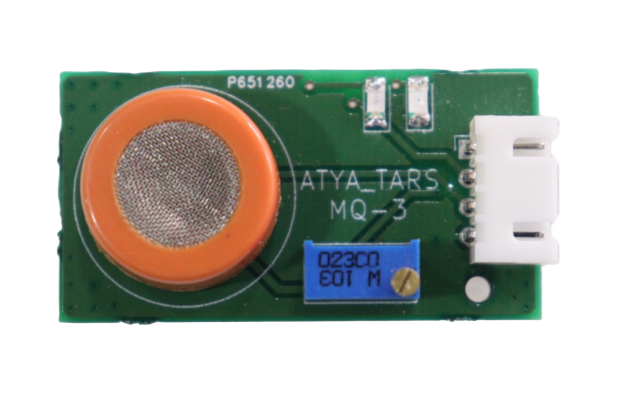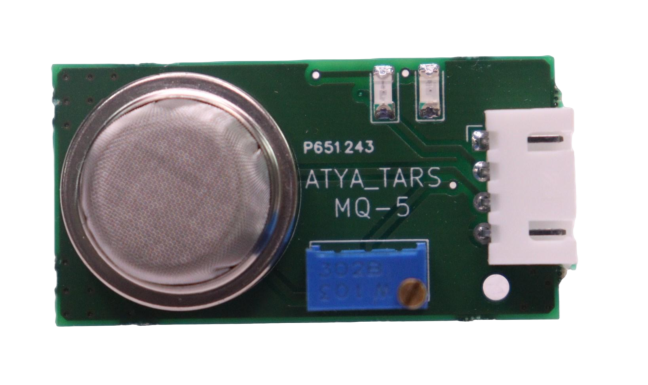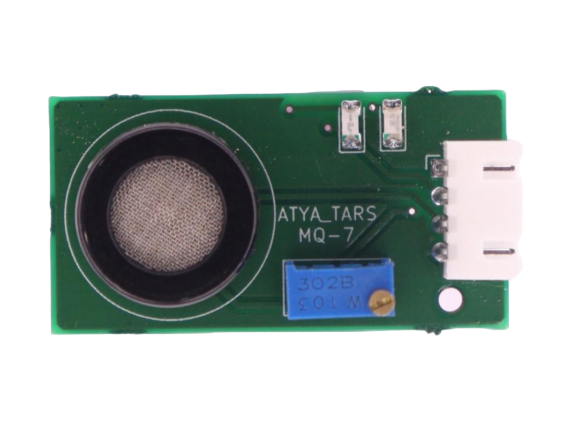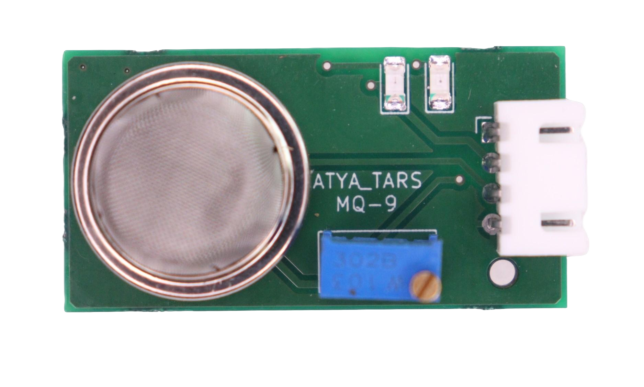MQ-2

General Description:
The gas sensor (MQ2) module is useful for gas leakage detection (home and industry). It is suitable for detecting H2, LPG, CH4, CO, Alcohol, Smoke, or Propane. Due to its high sensitivity and fast response time, measurements can be taken as soon as possible. The sensitivity of the sensor can be adjusted by a potentiometer.
Working Principle:
The MQ-2 gas sensor employs a tin dioxide (SnO2) based sensing element, heated for optimal performance. In the presence of oxygen, the sensor's surface is coated with oxygen ions, hindering electron flow and maintaining a high resistance state. When exposed to reducing gases, these oxygen ions are consumed, leading to a decrease in the sensor's resistance and enabling current flow. This change in conductivity is proportional to the concentration of the gas, allowing for the quantification of gas levels based on the sensor's output voltage.
Specifications:
1. Having an IC chip LM393 voltage comparator.
2. Operating Voltage (VCC) is 3v-5v.
3. It has the signal output indicating led.
4. Having the dual signal output (analog and TTL output).
5. Long working life and stable performance by MQ-2.
6. It is highly sensitive to Gas Methane (CNG) detectors.
7. Operating Temperature: -10°C to 50°C.
Requirements
| S. No. | Component Name | Values |
|---|---|---|
| 1 | LM393 (Voltage Comparator) IC | |
| 2 | MQ-2 Gas Sensor | |
| 3 | Resistors | 472 |
| 4 | Capacitors | 106,104,105 |
| 5 | Male connectors | 4 |
| 6 | Variable potentiometer | 10k |
| 7 | Inductor | 100uH |
Pin configuration:
| S. No. | Pins | Pin Description |
|---|---|---|
| 1 | SIG | Output pin |
| 2 | NC | No connection |
| 3 | VCC | Input voltage (3V to 5V) |
| 4 | GND | ground |
Pin Diagrams:

Applications:
1. Gas leakage detection.
2. Toys.
3. IoT Applications.
4. Smart Detections.
For more info: Refer the Datasheets!
MQ-3

General Description:
MQ-3 Alcohol Detector Module which can sense the presence of Alcohol in the air. It provides an analog output corresponding to the concentration of the gas in the air and an easy-to-use digital output. The onboard potentiometer can be used to set the maximum gas concentration beyond which the digital output gets triggered. Just power the module with 5V set the threshold and you can start getting the gas concentration of the air around the sensor. An onboard LED signals the presence of any gas. Perfect sensing alcohol concentration on your breath just like a common breathalyser.
Working Principle:
The MQ-3 gas sensor utilizes a semiconductor material, such as tin dioxide, as its sensing element. When powered, the built-in heater element raises the semiconductor's temperature, rendering it catalytically active. Upon exposure to alcohol vapor, the surface conductivity of the semiconductor changes, resulting in a measurable alteration in electrical resistance. This change in resistance is then translated into a voltage signal for alcohol concentration detection. MQ-3 gas sensor applies SnO2 which has a lower conductivity in the clear air as a gas-sensing material. In an atmosphere where there may be alcohol gas, the conductivity of the gas sensor rises along with the concentration of the alcohol gas increases.
Specifications:
1. Operating voltage: 2.5 V to 5 V.
2. Boost converter to boost the sensor sensitivity.
3. It has the signal output indicating led.
4. This sensor is Sensitive to alcohol, and ethanol.
5. And having the adjustable sensitivity.
6. Having the Analog and digital output.
Requirements
| S. No. | Component Name | Values |
|---|---|---|
| 1 | LM393 (Voltage Comparator) IC | |
| 2 | MQ-3 Gas Sensorr | |
| 3 | PT1301 (low voltage DC-DC converter) | 472 |
| 4 | Resistors | 10k, 4.7k, |
| 5 | Capacitors | 100n |
| 6 | Male connectors | 4 |
| 7 | LED | |
| 8 | Variable Potentiometer | 10k |
| 9 | Inductor | 10uH |
Pin configuration:
| S. No. | Pins | Pin Description |
|---|---|---|
| 1 | DOUT | Digital Pin |
| 2 | AOUT | Analog Pin |
| 3 | GND | ground |
| 4 | VCC | Input voltage (2V to 5V) |
Pin Diagrams:

Applications:
1. Automotive safety systems.
2. Breathalyzer devices.
3. Industrial safety monitoring.
4. Home automation.
5. Drunk driving incidents.
For more info: Refer the Datasheets!
MQ-4

General Description:
The MQ-4 High Sensitivity Gas Methane (CNG) Detector Gas Sensor Module is a quite good solution. This is a simple-to-use MQ-4 High Sensitivity Gas Methane (CNG) Detector Sensor Module that can sense the presence of Compressed Natural Gas (CNG), methane (CH4), etc in the air. The module uses our MQ-4 sensor. It simplifies the interface to the odd pin spacing of the sensor. It provides an analog output corresponding to the concentration of the gases in the air and an easy-to-use digital output. The onboard potentiometer can be used to set the maximum gas concentration beyond which the digital output gets triggered.
Working Principle:
The MQ-4 gas sensor operates based on the conductivity changes of its tin dioxide sensing material when exposed to methane or natural gas. Integrated with a heating element, the sensor elevates the temperature of the material to facilitate chemical reactions with the target gas. In the presence of methane or natural gas, the interaction reduces the conductivity of the material, altering the electrical output of the sensor. This output, proportional to gas concentration, enables accurate detection for applications like gas leakage monitoring and safety systems.
Specifications:
1. Having an IC chip LM393 voltage comparator.
2. Operating Voltage (VDC) is 3V-5V.
3. It has the signal output indicating LED.
4. Having the dual signal output (analog and TTL output).
5. Long working life and stable performance by MQ-4.
6. It is highly sensitive to Gas Methane (CNG) detectors.
7. Operating Temperature: -10°C to 50°C.
Requirements
| S. No. | Component Name | Values |
|---|---|---|
| 1 | LM393 (Voltage Comparator) IC | |
| 2 | MQ-4 Gas Sensorr | |
| 3 | Resistors | 472 |
| 4 | Capacitors | 106,104,105(n) |
| 5 | Male connectors | 4 |
| 6 | Variable potentiometer | 10k |
Pin configuration:
| S. No. | Pins | Pin Description |
|---|---|---|
| 1 | VCC | Input voltage (3V to 5V) |
| 2 | GND | ground |
| 3 | D0 | Digital pin |
| 4 | A0 | Analog pin |
Pin Diagrams:

Applications:
1. Gas leakage detection.
2. Home and industrial safety systems.
3. Air quality monitoring.
4. Environmental Monitoring.
5. Industrial Processes.
For more info: Refer the Datasheets!
MQ-5

General Description:
MQ5 is a sensitive gas sensor that can detect or sense liquefied gas, propane, butane, natural, and other combustible gases in the environment. And, hence used in gas leakage detectors, and other industrial gas detectors, or monitoring devices. The output voltage of this MQ5 Gas sensor increases when the concentration of gases or a gas increases. Due to its high sensitivity and fast response time, measurements can be taken as soon as possible. The sensitivity of the sensor can be adjusted by using the potentiometer.
Working Principle:
The MQ-5 gas sensor utilizes a sensitive SnO2 filament that changes conductivity when exposed to combustible gases like LPG, correlating with gas concentration. This change in conductivity or resistance corresponds to the gas concentration. The effect is more pronounced at higher temperatures, aided by a resistive heating element. SnO2 exhibits high sensitivity to Methane, Butane, and Propane, while also detecting other combustible gases. The heating coil, in contact with the SnO2 filament, maintains a consistent resistance in clean air. However, when a combustible gas is present, SnO2 filament resistance drops, causing an increase in Output Voltage (Vout). This voltage shift can be measured to ascertain the concentration of the detected combustible gas.
Specifications:
1. Operating Voltage (VDC) is 5V DC.
2. Having an IC chip LM393 voltage comparator.
3. The resistance of the heater element is 31% with a tolerance of ±10%.
4. The sensor features adjustable resistance.
5. Operating Temperature: -20 to 40 °C.
6. It exhibits high sensitivity to LPG (liquefied petroleum gas), natural gas, and town gas. It has a lower sensitivity to alcohol and smoke.
7. It is stable and has a long lifespan.
8. It has a fast response time.
9. Detecting Concentration: The sensor can detect gas concentrations ranging from 200 to 10,000 parts per million (ppm).
Requirements
| S. No. | Component Name | Values |
|---|---|---|
| 1 | LM393 (Voltage Comparator) IC | |
| 2 | MQ-5 Gas Sensorr | |
| 3 | Resistors | 10k, 47k, 5.1 Ω,1k |
| 4 | Capacitors | 104 μF |
| 5 | Male connectors (digital/analog) | 4 |
| 6 | Variable potentiometer | 10k |
| 7 | LED |
Pin configuration:
| S. No. | Pins | Pin Description |
|---|---|---|
| 1 | AOUT | Analog data output |
| 2 | DOUT | Digital data output |
| 3 | GND | Ground |
| 4 | 5V(Vcc) | Input voltage (3V to 5V) |
Pin Diagrams:

Applications:
1. Gas leakage detection.
2. Toys.
3. Portable Natural Gas Detectors.
4. Industrial flammable gas alarm.
5. Domestic gas leakage alarm.
For more info: Refer the Datasheets!
MQ-6

General Description:
The MQ6 Gas Sensor is a type of gas detection device that is designed to detect specific gases in the air, particularly Liquefied Petroleum Gas (LPG), Isobutane, and Propane. These gases are commonly used in household appliances like stoves, heaters, and gas-powered vehicles. The MQ-6 sensor module is part of the MQ series of gas sensors produced by the company Winsen, and it operates based on the principle of chemical resistance change.
Working Principle:
The MQ-6 gas sensor operates on gas conductivity principles, reacting to specific gases with its sensitive layer. When the target gas contacts the sensor, its electrical resistance changes, generating an electrical signal. This signal's voltage varies with gas concentration, typically decreasing as the concentration rises. An analog-to-digital converter (ADC) reads this voltage for microcontroller processing. Environmental factors like temperature and humidity influence sensor output, requiring calibration for accuracy. Preheating the sensor ensures reliable readings.
Specifications:
1. It operates on a voltage of 5V DC.
2. Detecting Range: It can detect gas concentrations within the range of 200 to 10,000 parts per million (ppm).
3. Relative Humidity: 95% RH.
4. It operates within a temperature range of -20 to 40 degrees Celsius.
5. Having an IC chip LM393 voltage comparator.
6. Good sensitivity to Combustible gas in a wide range.
7. High sensitivity to Propane, Butane, and LPG.
8. An indication of the signal output.
9. Dual signal output (analog output, and TTL level output).
10. High sensitivity to hydrogen.
11. Can be resistant to ethanol steam, LPG (petroleum), and smoke interference.
Requirements
| S. No. | Component Name | Values |
|---|---|---|
| 1 | LM393 (Voltage Comparator) IC | |
| 2 | MQ-6 Gas Sensorr | |
| 3 | Resistors | 10k, 1k, 5.1 Ω |
| 4 | Capacitors | 104 μF |
| 5 | Male connectors (digital/analog) | 4 |
| 6 | Variable potentiometer | 10k |
| 7 | LED |
Pin configuration:
| S. No. | Pins | Pin Description |
|---|---|---|
| 1 | VCC | Input voltage (3V to 5V) |
| 2 | GND | Ground |
| 3 | D0 | Digital pin |
| 4 | A0 | Analog pin |
Pin Diagrams:

Applications:
1. The domestic gas leakage detector.
2. Industrial Combustible gas detector.
3. Portable gas detector.
4. Safety standard maintenance.
5. Maintaining environmental standards in hospitals.
For more info: Refer the Datasheets!
MQ-7

General Description:
The sensitive material of the MQ-7 gas sensor is SnO2, which with lower conductivity in clean air. It makes detection by method of cycle high and low temperature and detects CO when low temperature (heated by 1.5V). The sensor's conductivity is higher along with the gas concentration rising. When high temperature (heated by 5.0V), it cleans the other gases adsorbed under low temperature. Please use a simple electro-circuit and convert the change of conductivity to the corresponding output signal of gas concentration.MQ-7 gas sensor has high sensitivity to Carbon Monoxide. The sensor could be used to detect different gases containing CO, it is low cost and suitable for different application
Working Principle:
The MQ-7 gas sensor employs a tin dioxide (SnO2) based sensing element, heated for optimal performance. In the presence of oxygen, the sensor's surface is coated with oxygen ions, hindering electron flow and maintaining a high resistance state. When exposed to reducing gases, these oxygen ions are consumed, leading to a decrease in the sensor's resistance and enabling current flow. This change in conductivity is proportional to the gas concentration, allowing for the quantification of gas levels based on the sensor's output voltage.
Specifications:
1. Having an IC chip LM393 voltage comparator.
2. Operating Voltage (VDC) is 3v-5v.
3. It has the signal output indicating led.
4. Having the dual signal output (analog and TTL output).
5. It is highly sensitive to CO.
5. Operating Temperature: -10°C to 50°C.
Requirements
| S. No. | Component Name | Values |
|---|---|---|
| 1 | LM393 (Voltage Comparator) IC | |
| 2 | MQ-7 Gas Sensorr | |
| 3 | Resistors | 472 |
| 4 | Capacitors | 106,104,105 |
| 5 | Male connectors | 4 |
| 6 | Variable potentiometer | 10k |
| 7 | LED |
Pin configuration:
| S. No. | Pins | Pin Description |
|---|---|---|
| 1 | DOUT | Digital output pin |
| 2 | AOUT | Analog output pin |
| 3 | GND | Connect to ground |
| 4 | VCC | Input voltage (3V to 5V) |
Pin Diagrams:

Applications:
1. Domestic gas leakage detector.
2. Industrial CO detector.
3. Portable gas detector.
For more info: Refer the Datasheets!
MQ-8

General Description:
A sensitive material MQ-8 Hydrogen Gas Sensor Module H2 Alarm Detection used in clean air low conductivity tin oxide (SnO2). When there is the environment in which the combustible gas sensor, the conductivity sensor with increasing concentration of combustible gases in the air increases.
Working Principle:
A gas sensor can detect the concentration of a specific gas in the air. Depending upon the concentration of the gas, the sensor generates a potential difference by changing the resistance of the sensing element, which can then be measured as the output voltage. MQ-8 hydrogen gas sensor consists of a sensing element which is aluminum-oxide-based ceramic, coated with tin dioxide (SnO2), enclosed in a stainless-steel mesh. In the case of any H2 in the air, the resistivity of the sensing element changes, and the change is measured to get the concentration of the gas present. MQ-8 sensor can detect H2 in the concentration range of 100-1000ppm.
Specifications:
1. This sensor operates with 5V DC.
2. It detects hydrogen concentration within the air.
3. Resistant to smoke, LPG, and alcohol.
4. Power consumption of heater is below 800mW.
5. The range of gas detection ranges from 100 - 1000ppm.
6. Dual signal output.
7. Quick response.
8. Very sensitive to Hydrogen gas.
Requirements
| S. No. | Component Name | Values |
|---|---|---|
| 1 | LM393 (Voltage Comparator) IC | |
| 2 | MQ-8 Gas Sensorr | |
| 3 | Resistors | 472 |
| 4 | Capacitors | 106,104,105 |
| 5 | Male connectors | 4 |
| 6 | Variable potentiometer | 10k |
| 7 | LED |
Pin configuration:
| S. No. | Pins | Pin Description |
|---|---|---|
| 1 | VCC | Input voltage (3V to 5V) |
| 2 | GND | ground |
| 3 | D0 | Digital pin |
| 4 | A0 | Analog pin |
Pin Diagrams:

Applications:
1. This sensor is used to measure the hydrogen concentration within the air.
2. It detects gas leakages within the industry.
3. The gas sensor is used in mines.
4. Used in AC & refrigerators.
For more info: Refer the Datasheets!
MQ-9

General Description:
This MQ-9 Carbon Monoxide, Methane, and LPG Gas Sensor Module can be used to sense Carbon Monoxide and Methane Gas. The sensitive material of the MQ9 gas sensor is SnO2, which with lower conductivity in clean air. It makes detection by the method of cycle high and low temperature and detects CO when the low temperature (heated by 1.5V). The sensor's conductivity is higher along with the gas concentration rising. When a high temperature (heated by 5.0V), it detects Methane, Propane, etc. combustible gas and cleans the other gases adsorbed under low temperature.
Working Principle:
This MQ9 Smoke Sensor contains a sensing element, mainly aluminum-oxide-based ceramic, coated with Tin dioxide (SnO2), enclosed in a stainless-steel mesh. Whenever gas comes into contact with the sensing element, the resistivity of the element changes. The change is then measured to get the concentration of the gases present. It has a small heating element present which is needed to preheat the sensor to get it in the working window. It can detect LPG, Propene, Hydrogen, Carbon Monoxide, and Methane Gas concentrations. It finds uses in detecting gas leakage in pipelines and alarm applications in case of a gas leak at home as CO is a very harmful gas and can kill a person if present over 300PPM.
Specifications:
1. This sensor operates with 5V DC.
2. It detects hydrogen concentration within the air.
3. Resistant to smoke, LPG, and alcohol.
4. Power consumption of heater is below 800mW.
5. The range of gas detection ranges from 100 - 1000ppm.
6. Dual signal output.
7. Quick response.
8. Reliable and long service life.
9. Very sensitive to Hydrogen gas.
Requirements
| S. No. | Component Name | Values |
|---|---|---|
| 1 | LM393 (Voltage Comparator) IC | |
| 2 | MQ-9 Gas Sensorr | |
| 3 | Resistors | 472 |
| 4 | Capacitors | 106,104,105 |
| 5 | Male connectors | 4 |
| 6 | Variable potentiometer | 10k |
| 7 | LED |
Pin configuration:
| S. No. | Pins | Pin Description |
|---|---|---|
| 1 | VCC | Input voltage (3V to 5V) |
| 2 | GND | ground |
| 3 | D0 | Digital pin |
| 4 | A0 | Analog pin |
Pin Diagrams:

Applications:
1. The domestic gas leakage detector.
2. Industrial gas detector.
3. Portable gas detector.
For more info: Refer the Datasheets!
MQ-131

General Description:
The sensitive material of the MQ-131 gas sensor is O3 SnO2, which with lower conductivity in clean air. When Ozone gas exists. The sensor's conductivity is higher along with the gas concentration rising. Please use a simple electro-circuit and convert the change of conductivity to the corresponding output signal of gas concentration. MQ-131 gas sensor has a high sensitivity to Ozone, also sensitive to O3 CL2, NO2, etc.
Working Principle:
The MQ131 gas sensor utilizes a semiconductor-based chemo-resistive sensing mechanism to detect ozone in the air. Its tin dioxide (SnO2) sensing material changes electrical resistance when exposed to ozone molecules, thanks to a built-in heating element that elevates its temperature. This resistance change is converted into an electrical signal proportional to ozone concentration, providing accurate measurements. Calibration ensures precise readings, making the MQ131 sensor an effective tool for monitoring ozone levels in various environments.
Specifications:
1. Having an IC chip LM393 voltage comparator.
2. Operating Voltage (VDC) is 3V-5V.
3. Mounting holes to facilitate fixed installation.
4. It has the signal output indicating LED.
5. Having the dual signal output (analog and TTL output).
6. Long working life and stable performance by MQ-131.
7. The ozone gas with high sensitivity (detection concentration range 10PPB-2PPM Ozone).
8. Operating Temperature: -10°C to 50°C.
Requirements
| S. No. | Component Name | Values |
|---|---|---|
| 1 | LM393 (Voltage Comparator) IC | |
| 2 | MQ-131 Gas Sensorr | |
| 3 | Resistors | 472R |
| 4 | Capacitors | 106,104,105(n) |
| 5 | Male connectors | 4 |
| 6 | Variable potentiometer | 10k |
Pin configuration:
| S. No. | Pins | Pin Description |
|---|---|---|
| 1 | VCC | Input voltage (3V to 5V) |
| 2 | GND | ground |
| 3 | D0 | Digital pin |
| 4 | A0 | Analog pin |
Pin Diagrams:

Applications:
1. The domestic gas leakage detector.
2. Industrial gas detector.
3. Portable gas detector.










